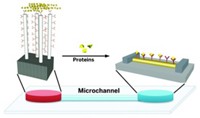Advertisement
Grab your lab coat. Let's get started
Welcome!
Welcome!
Create an account below to get 6 C&EN articles per month, receive newsletters and more - all free.
It seems this is your first time logging in online. Please enter the following information to continue.
As an ACS member you automatically get access to this site. All we need is few more details to create your reading experience.
Not you? Sign in with a different account.
Not you? Sign in with a different account.
ERROR 1
ERROR 1
ERROR 2
ERROR 2
ERROR 2
ERROR 2
ERROR 2
Password and Confirm password must match.
If you have an ACS member number, please enter it here so we can link this account to your membership. (optional)
ERROR 2
ACS values your privacy. By submitting your information, you are gaining access to C&EN and subscribing to our weekly newsletter. We use the information you provide to make your reading experience better, and we will never sell your data to third party members.
Analytical Chemistry
Single-Molecule Assay Detects Cancer
Quanterix has developed an assay that is ultrasensitive for detecting a cancer biomarker
by David Pittman
May 31, 2010
| A version of this story appeared in
Volume 88, Issue 22

A Massachusetts company has developed an assay that is 1,700 times more sensitive for detecting a cancer biomarker than existing tests (Nat. Biotechnol., DOI: 10.1038/nbt.1641). The technology, which Cambridge-based Quanterix calls SiMoA (single-molecule array), uses femtoliter-sized chambers to individually isolate antibody-coated microbeads that trap single biomarker molecules. Labeling the biomarker with an enzyme permits its detection by fluorescence microscopy. Quanterix researchers led by David C. Duffy in collaboration with Tufts University’s David R. Walt have shown SiMoA’s effectiveness in detecting prostate-specific antigen (PSA) in blood samples. PSA is produced by the prostate in exponentially higher levels when cancer is present in the gland. Current assays measure PSA concentrations down to 10–12 M, but the Quanterix assay allows PSA detection in blood at concentrations of 10–15 M, the researchers note. Duffy says a simple blood test using SiMoA could detect any residual cancer or cancer recurrence after surgery. The technology is due to launch in 2011 with clinical studies to follow, he adds. The researchers hope the ability to detect single protein molecules will accelerate the discovery of additional concentration-sensitive diagnostic biomarkers that lend themselves to monitoring diseases.



Join the conversation
Contact the reporter
Submit a Letter to the Editor for publication
Engage with us on Twitter